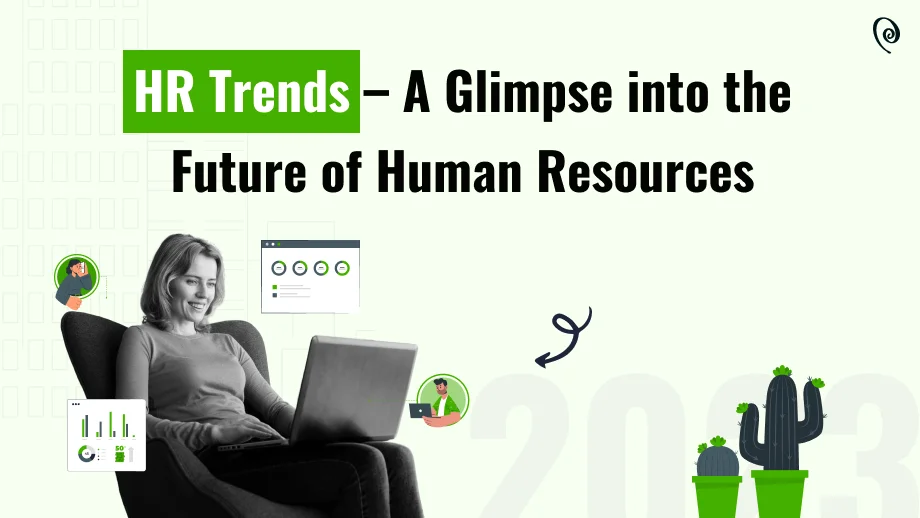
HR Trends: The Future of Human Resources – Navigating Tomorrow’s Workforce
Human Resources (HR) isn’t just about hiring and firing anymore. In fact, if you still think of HR that way, you’re missing out on one of the most exciting and rapidly evolving fields in the business world! The landscape of work is changing at an unprecedented pace, driven by new technologies, shifting employee expectations, and a globalized marketplace.
For beginners, think of HR as the "people department." But it’s so much more than just paperwork. Modern HR is about creating a thriving environment where people can do their best work, feel valued, and contribute to the success of the organization. It’s about strategy, culture, well-being, and leveraging data to make smart decisions about people.
This article will take you on a journey through the most significant HR trends shaping the future of Human Resources. We’ll break down complex ideas into easy-to-understand concepts, showing you how HR is becoming a powerful force for innovation and growth.
Why HR Trends Matter: The Heart of Business Success
Before we dive into the specific trends, let’s understand why this matters. In today’s competitive world, a company’s greatest asset isn’t its products, patents, or even its cash reserves – it’s its people.
When HR is proactive and strategic, it directly impacts:
- Talent Attraction: How easily a company can find and hire the best people.
- Employee Retention: How well a company keeps its valuable employees from leaving.
- Productivity & Innovation: How engaged and effective employees are.
- Company Culture: The overall feeling and values of the workplace.
- Financial Performance: Engaged employees and efficient processes lead to better business results.
Understanding these HR trends isn’t just for HR professionals; it’s crucial for business leaders, managers, and anyone interested in the world of work.
Key HR Trends Shaping the Future of Human Resources
Let’s explore the most impactful trends that are redefining HR.
1. Digital Transformation & The Rise of HR Tech (AI & Automation)
One of the biggest shifts in HR is the embrace of technology. Just like every other part of a business, HR is becoming more digital, using smart tools to make things faster, more accurate, and more personalized.
What it means for HR:
- Automation of Routine Tasks: Think about all the repetitive HR tasks – scheduling interviews, sending onboarding documents, managing leave requests. AI (Artificial Intelligence) and automation can handle these, freeing up HR professionals for more strategic work.
- AI-Powered Recruitment: AI tools can scan thousands of resumes, identify ideal candidates, and even conduct initial chatbot interviews. This speeds up hiring and reduces human bias.
- Personalized Employee Experiences: AI can recommend learning courses based on an employee’s career goals, or suggest well-being resources tailored to their needs.
- Data Analysis: HR software can collect and analyze vast amounts of data about employee performance, engagement, and even flight risk (who might leave). This helps HR make data-driven decisions.
Impact on the workforce:
- Faster, Smoother Processes: Employees get quicker responses and less administrative hassle.
- Focus on Human Connection: With mundane tasks automated, HR can spend more time on coaching, mentorship, and building relationships.
- New Skills Needed: HR professionals need to be tech-savvy and understand how to use these new tools effectively.
2. The Dominance of Hybrid & Flexible Work Models
The pandemic accelerated a trend that was already bubbling: the shift away from the traditional 9-to-5, in-office work model. Hybrid work (a mix of in-office and remote) and fully remote setups are now common.
What it means for HR:
- Policy Development: HR is responsible for creating fair and effective policies for hybrid work, including guidelines for remote work, technology use, and office days.
- Maintaining Culture & Connection: How do you build a strong company culture when not everyone is in the same place? HR needs to find innovative ways to foster teamwork, communication, and a sense of belonging.
- Ensuring Equity: HR must ensure that remote employees have the same opportunities for growth and recognition as in-office employees. This includes access to technology, training, and leadership visibility.
- Measuring Productivity: Shifting focus from "face time" to results and output.
Impact on the workforce:
- Increased Flexibility: Employees have more control over where and when they work, leading to better work-life balance.
- Wider Talent Pool: Companies can hire people from anywhere, not just within commuting distance, opening up opportunities for both employers and job seekers.
- Challenges: Potential for isolation, communication breakdowns, and burnout if not managed well.
3. Elevating the Employee Experience (EX) & Well-being
Think of the "Employee Experience" (EX) as everything an employee encounters, observes, or feels throughout their journey with a company. It’s about making work a positive and engaging part of their life. This goes far beyond just "employee satisfaction."
What it means for HR:
- Holistic Approach: EX covers everything from the recruitment process, onboarding, daily work, career development, benefits, and even offboarding.
- Focus on Well-being: This includes mental health support, physical wellness programs, financial literacy resources, and ensuring a healthy work-life balance. Burnout is a major concern, and HR is on the front lines of addressing it.
- Personalization: Understanding individual employee needs and tailoring support, development, and recognition.
- Gathering Feedback: Regularly surveying employees, conducting stay interviews, and using feedback to improve the work environment.
Impact on the workforce:
- Higher Engagement & Productivity: Happy and supported employees are more likely to be engaged and perform better.
- Improved Retention: When employees feel valued and cared for, they are less likely to look for opportunities elsewhere.
- Stronger Employer Brand: A positive EX makes a company more attractive to new talent.
4. Deepening Diversity, Equity, and Inclusion (DEI)
DEI is no longer just a buzzword; it’s a fundamental business imperative.
- Diversity: Having a workforce with a wide range of backgrounds, experiences, and perspectives (e.g., gender, ethnicity, age, sexual orientation, disability, socioeconomic background).
- Equity: Ensuring fair treatment, access, opportunity, and advancement for all, while striving to identify and eliminate barriers that have prevented the full participation of some groups.
- Inclusion: Creating an environment where every individual feels welcomed, respected, supported, and valued, and can fully participate and contribute.
What it means for HR:
- Bias Mitigation: Implementing processes (e.g., blind resume reviews, diverse interview panels) to reduce unconscious bias in hiring and promotion.
- Inclusive Policies: Developing policies that support all employees, such as flexible work arrangements, inclusive benefits, and anti-discrimination policies.
- Training & Education: Providing training on unconscious bias, cultural competence, and inclusive leadership for all employees.
- Accountability: Setting DEI goals, measuring progress, and holding leaders accountable for creating an inclusive culture.
Impact on the workforce:
- Richer Perspectives: Diverse teams lead to more innovative ideas and better problem-solving.
- Stronger Culture: An inclusive environment makes employees feel safer, more authentic, and more willing to contribute.
- Better Business Outcomes: Research consistently shows that diverse and inclusive companies outperform their peers.
5. A Skills-First Approach & Continuous Learning (Upskilling/Reskilling)
The world of work is changing so rapidly that the skills needed today might be obsolete tomorrow. This means companies need to focus less on degrees and more on the skills employees have and can acquire.
What it means for HR:
- Skills Mapping: Identifying the skills employees currently have and the skills the company will need in the future.
- Learning & Development (L&D): Investing heavily in programs for "upskilling" (teaching new, advanced skills for a current role) and "reskilling" (teaching entirely new skills for a different role).
- Internal Mobility: Creating pathways for employees to move into new roles within the company based on their acquired skills.
- Building a Learning Culture: Encouraging employees to be lifelong learners and providing resources for continuous development.
Impact on the workforce:
- Career Growth: Employees have more opportunities to develop new skills and advance their careers within the same organization.
- Job Security: Staying relevant in a changing job market.
- Adaptability: A workforce that can quickly learn new skills is more agile and better prepared for future challenges.
6. Data-Driven HR & People Analytics
Gone are the days when HR relied solely on gut feelings. Modern HR uses data to make informed decisions, just like sales or marketing departments. "People Analytics" is about collecting, analyzing, and reporting on data related to people and their impact on business outcomes.
What it means for HR:
- Strategic Insights: Using data to understand patterns in employee turnover, identify high-performing teams, or predict future talent needs.
- Measuring Impact: Proving the value of HR initiatives by showing their measurable impact on the business (e.g., how a new training program improved productivity).
- Predictive Analytics: Using historical data to forecast future trends, such as which employees are at risk of leaving or where skill gaps might emerge.
- Evidence-Based Decisions: Moving from "I think" to "the data shows."
Impact on the workforce:
- Fairer Decisions: Decisions about promotions, compensation, and development can be based on objective data rather than subjective opinions.
- Targeted Support: HR can identify specific groups or individuals who need support (e.g., teams with high stress levels) and provide targeted interventions.
- Improved Work Environment: Data insights can reveal underlying issues that, once addressed, lead to a better workplace for everyone.
7. Purpose-Driven Work & Environmental, Social, and Governance (ESG)
Today’s employees, especially younger generations, want more than just a paycheck. They want to work for companies that have a positive impact on the world and align with their personal values. This ties into Environmental, Social, and Governance (ESG) principles.
- Environmental: How a company impacts the planet (e.g., carbon footprint, sustainability).
- Social: How a company manages relationships with its employees, suppliers, customers, and communities (e.g., labor practices, diversity, community engagement).
- Governance: How a company is led, including leadership structure, executive pay, audits, and shareholder rights.
What it means for HR:
- Articulating Purpose: Helping the company define and communicate its mission, vision, and values in a way that resonates with employees.
- ESG Integration: Ensuring that HR policies and practices reflect the company’s commitment to ESG, from fair labor practices to ethical supply chains.
- Employee Engagement in ESG: Creating opportunities for employees to participate in social impact initiatives, volunteering, or sustainability efforts.
- Attracting Values-Aligned Talent: Highlighting the company’s purpose and ESG efforts in recruitment to attract candidates who share those values.
Impact on the workforce:
- Increased Engagement & Loyalty: Employees feel more connected and committed to a company that stands for something meaningful.
- Sense of Contribution: Knowing that their work contributes to a larger, positive impact.
- Stronger Culture: A shared sense of purpose fosters unity and pride.
The Evolving Role of the HR Professional
With all these changes, the job of an HR professional is transforming dramatically. They are no longer just administrators; they are becoming:
- Strategic Business Partners: Working closely with leaders to align people strategies with overall business goals.
- Technology Integrators: Understanding and implementing new HR technologies.
- Data Scientists: Interpreting people analytics to make informed decisions.
- Culture Architects: Designing and nurturing a positive and inclusive workplace culture.
- Employee Advocates: Ensuring employees’ voices are heard and their well-being is prioritized.
- Change Agents: Guiding organizations and employees through constant change and disruption.
This requires a new set of skills, including critical thinking, adaptability, digital literacy, empathy, and strong communication.
Preparing for the Future: How Organizations Can Adapt
For any organization to thrive in this new HR landscape, it needs to:
- Embrace Technology: Invest in modern HR software and tools, and train HR teams to use them effectively.
- Prioritize Employee Well-being: Go beyond basic benefits to offer holistic support for mental, physical, and financial health.
- Foster a Culture of Learning: Create opportunities and encouragement for continuous upskilling and reskilling.
- Lead with Empathy & Inclusion: Build a genuinely diverse, equitable, and inclusive workplace where everyone feels they belong.
- Leverage Data: Move towards data-driven decision-making in all HR functions.
- Be Flexible: Adapt to new work models and employee expectations.
- Define and Live Your Purpose: Clearly articulate company values and demonstrate commitment to ESG principles.
- Empower HR: Elevate HR to a strategic leadership position within the organization.
Conclusion: The Human Touch in a Digital Age
The future of Human Resources is exciting, complex, and incredibly vital. While technology and data are transforming HR processes, the core of HR remains profoundly human. It’s about understanding people, fostering connections, supporting growth, and creating environments where individuals and organizations can flourish together.
The HR trends we’ve explored—from AI and flexible work to DEI and purpose-driven work—all point towards a more strategic, data-informed, and people-centric approach to managing a workforce. For beginners, this means a dynamic and impactful career path, and for businesses, it means unlocking the full potential of their greatest asset: their people. By embracing these changes, HR is not just adapting to the future; it’s actively shaping it.



Post Comment